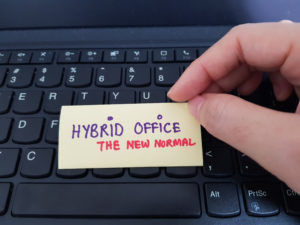By Tracy Long & Tracy Emmerich
2022 has ushered in a few changes in the COVID landscape as it pertains to CalOSHA’s ETS and supplemental paid sick leave (SPSL).

In this issue of our newsletter:
- CalOSHA COVID-19 Prevention Emergency Temporary Standard (ETS)
- 2022 California COVID-19 Supplemental Paid Sick Leave (SPSL)
- Frequently Asked Questions

CalOSHA COVID-19 Prevention Emergency Temporary Standard (ETS)
Effective May 6, 2022, CalOSHA revised the COVID-19 Prevention ETS for the third time. This re-adoption is effective through December 31, 2022. (Note that high-risk settings may follow different protocols). Changes were made to allow more consistency and flexibility with the California Department of Public Health (CDPH) guidance. The changes include, but are not limited to:
• Face coverings are mandatory when CDPH requires their use. Requirements are the same for all employees regardless of vaccination status.
• Cleaning and disinfecting requirements were deleted.
• Respirators must be provided for voluntary use to employees who request them.
• Employers must offer COVID-19 testing at no cost to the employees, during paid time to:
›Symptomatic employees, regardless of vaccination status and regardless of whether there is a known exposure.
›All employees, regardless of vaccination status, who have had close contact with someone who has tested positive for COVID-19 (except those recently recovered).
›All employees, regardless of vaccination status, in an outbreak/major outbreak (except recently recovered or those not at work during the high-exposure period).
• Employees who test positive for COVID-19 must follow CDPH’s latest Isolation and Quarantine Guidance (The current version is dated 5/6/2022).
• Employees who have had close contact with someone who tested positive for COVID-19 must also follow CDPH’s latest Isolation and Quarantine Guidance
Requirements that are still in effect include, but are not limited to:
• Establishing, implementing, and maintaining an effective written COVID-19 Prevention Program.
• Providing effective training and instruction.
• Providing written notification to employees of exposure and close contacts.
• Responding to COVID-19 cases and outbreaks.
• Isolation and exclusion pay requirements.
HR2Leap Consultants can provide you with required resources and advice. Let us help you!

2022 California COVID-19 Supplemental Paid Sick Leave (SPSL)
Employers with 26 or more employees are subject to the SPSL law that went into effect in February 2022, but is retroactive to January 1, 2022. It remains in effect until September 30, 2022. SPSL provides up to 80 hours of COVID-19 related paid leave broken into two leave banks of up to 40 hours each (pro-rated if part-time).
Leave Bank 1 Covered Reasons
If the employee cannot work or telework due to a covered reason below:
Caring for Yourself: The covered employee is subject to a quarantine or isolation period related to COVID-19 (see note below), or has been advised by a healthcare provider to quarantine due to COVID-19, or is experiencing symptoms of COVID-19 and seeking a medical diagnosis.
Caring for a Family Member*: The covered employee is caring for a family member who is either subject to a quarantine or isolation period related to COVID-19 or has been advised by a healthcare provider to quarantine due to COVID-19, or the employee is caring for a child whose school or place of care is closed or unavailable due to COVID-19 on the premises.
Vaccine-Related**: The covered employee or a qualifying family member is attending a vaccine appointment or cannot work or telework due to vaccine-related side effects.
*Family member is defined as a child, parent, spouse, registered domestic partner, grandchild, grandparent, or sibling.
**Time off for a COVID-19 vaccine or booster shot and/or vaccine or booster shot symptoms can be limited to a combined three days or 24 hours for each vaccine/booster. However, more than three days may be available if a health care provider verifies the individual continues to experience symptoms related to the vaccine/booster.
Leave Bank 2 Covered Reasons
Employee tests positive or is caring for a family member who tests positive for COVID-19. Employers may require documentation of the positive test for leave for this reason.
COVID-19 SPSL Poster: https://www.dir.ca.gov/dlse/COVID19resources/2022-COVID-19-SPSL-Poster.pdf

Frequently Asked Questions:
Q: An employee is quarantined at home, because they have symptoms, but continues to test negative. We have more than 25 employees, are they eligible for COVID Supplemental Paid Sick Leave (SPSL)?
A: Symptomatic employees should be excluded and test as soon as possible. If the employee is unable to telework, they may request to use CSSP for “Caring for Yourself – experiencing symptoms of COVID-19 and seeking a medical diagnosis” up to the time that they receive their diagnosis. If the employee remains off work after a negative test result, they may request to use their regular Paid Sick Leave, if available. (Note: If the employee was exposed to someone who has COVID, CDPH recommends continuing exclusion and retesting in 1-2 days, particularly if the employee tested during the first 1-2 days of symptoms with an antigen test.) If the employee tests positive during a retest, then the employee may request CSSP for all time missed through the positive confirmation from one bank of leave (up to 40 hours) and they may use the second bank of leave for time off due to the positive test (up to 40 hours).
Q: I tested positive for COVID-19, but I feel better on day five but continue to test positive, can I return to work with a mask?
A: If your COVID test on day 5 (or later) is positive, you may not return to the workplace until after day 10 and only if you are fever-free for 24 hours without the use of fever-reducing medications. Employees who test negative on day 5 (or later), may return to the workplace if symptoms are not present or are resolving, however, they must wear a face covering around others for a total of 10 days.
Q: If I have less than 26 employees and we are not required to pay SPSL, how does my employee get paid if they or their family member has COVID or are symptomatic?
A: The employer does not need to maintain the employee’s earnings and benefits if the employee is unable to work because of COVID/symptoms, if the exposure happened outside of the workplace. Such employees may be eligible for other leave, including paid sick leave, or other benefits such as Disability Insurance, Paid Family Leave, or Unemployment Insurance Benefits.
Q: What is Exclusion Pay?
A: An employee who was excluded from work because of a workplace COVID-19 exposure should receive exclusion pay if: 1) the employee was not assigned to telework during that time; and 2) the employee did not receive Disability Payments or Workers’ Compensation Temporary Disability Payments during the exclusion period. You are not required to pay exclusion pay if COVID was not due to a workplace exclusion. Employers may not require employees who are excluded from work under the ETS to first exhaust 2022 COVID-19 Supplemental Paid Sick Leave.
Don’t hesitate to reach out to our HR2Leap Consultants for the latest COVID guidance!

***
Leap Solutions is a diverse group of highly skilled management professionals serving our clients with their organizational development, human resources, and executive search and recruitment needs. We have spent decades doing what we feel passionate about helping you feel passionate about what you do. With the ever-changing COVID-19 response, our HR specialists can help you get a handle on the guidelines, programs, and legislation that may impact you and your employees. Through all of our services, we are available to work with you to develop practical solutions and smart planning decisions for your organization’s immediate, near, and long-term needs.
To print this article, Click Here

![]()




